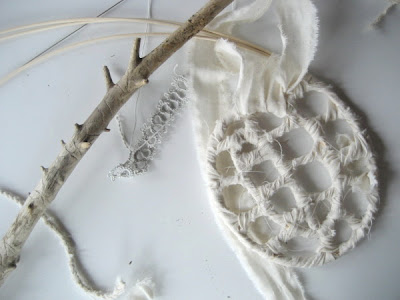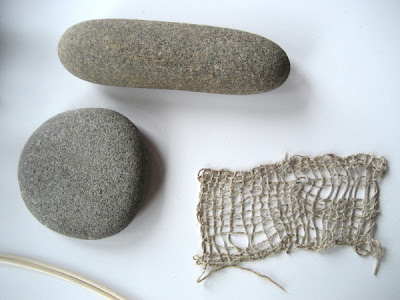



please click to see larger or go to flickr
each is approximately 2"x3"
A way to preserve the cursive script of hair, to bury and then excavate.
These delicate little sketches proved to be difficult to document, and though unsatisfied with the image on screen (too grey and blue) I still wanted to share.
11.25.2008
hair sketches
11.16.2008
11.15.2008
thread harvest
 April planting of five Upland Cotton seeds.
April planting of five Upland Cotton seeds.
September harvest of fourty-five bolls.
A boll is made up of four to five sections holding four to eight seeds.
Attached to each seed surface are many many fibers each of which is an outgrowth of a single cell that develops in the surface layer of the seed.
In the beginning the fiber cell elongates to its full length as a thin–walled tube. As it matures, the fiber wall is thickened by deposits of cellulose inside the tube, leaving a hollow area in the center. When the growth period ends the living material dies, and the fiber collapses and twists about its own axis.
Each boll may hold up to 500,000 fibers. Some prepare all those fibers before spinning by removing the seeds one by one and combing the fibers to roll them into little pencil sized punnis.
Some prepare all those fibers before spinning by removing the seeds one by one and combing the fibers to roll them into little pencil sized punnis.
With my handspindle I spun directly from the soft seeded mass. The fibers tearing from the seed bit by bit.
What will one boll make?
One spool of course.
 The cotton still blooms and a second harvest has nearly arrived.
The cotton still blooms and a second harvest has nearly arrived.
11.14.2008
sheep shear leads to wool gathering (of the serious sort)
Back in April, word of a spring sheep shearing nearby (in Florida!) reached my perked ears. Hands hungry for wool and feet inclined to go, I followed the directions given to me, and found myself unexpectedly at an 1840's homestead and festival. Fortunately persons with a drop spindle tucked under her arm were welcomed easily. So happily I sat for two days straight to glean from the people around me, as buttermilk biscuits and potato stew was cooked on a wood stove, water pumped, a log shed built, rope coiled, yarn spun, rag rugs and baskets woven, a native shared edible and medicinal plant lore, and there were even a few sheep sheared. Some of the wool even came home with me. My mind is still churning with it.

Gulf Coast Native Sheep are descendants of 1500s Spanish stock that developed into a tough breed resistant to Southeastern heat and internal parasites. As a result they were a favorite of southern homesteaders. Their heads, legs and bellies are bare to keep cool. They are listed on American Livestock Breeds Conservancy’s conservation's priority list as critical which means there are fewer than 200 annual registrations in the United States and estimated global population less than 5000. These days old lambs just added to that list.
 things noted:
things noted:
-wool can be spun unwashed "in the grease" to make waterproof clothing
-one of the fleeces brought home is from the ewe that recently birthed twins, it's significantly greasier than the ram or the other ewe's
-learned to make cordage from daylily leaves and agave, I later tried Spanish moss
-moss was once used to stuff horsehair furniture, and woven into horseblankets during the Civil War
-spanish moss may have use as a dye material (this is still unconfirmed)
-a woman raised angora rabbits that sat in her lap as she plucked hair and spun it on the wheel
-cotton was largely a cash crop for Florida homesteaders to be sold to the northern industries or exported to Britain . For themselves they raised sheep and flax to make clothing.
Perhaps the most striking bit of information:
Making clothing was a three year affair- the first year after the (up to six) sheep were sheared the wool would be skirted (manure laden bits were thrown in the garden for fertilizer) washed and carded and spun (usually with a drop spindle). The second year it was woven. The third year it was made into clothes and embellished. All the while raw wool was piling up in the attic to be processed in the next cycle.
Clothes had value far beyond what they do today. How many shirts and socks have I thrown away because of a small hole worn in the fabric? How easily would I have abandoned it if I spent three years making it? How did waste apply in the three year cycle? I imagine by the time cloth reached the trash pit it had gone from adult clothing, to children's clothing, to quilts, to patches, to rags, to wicks, to nothing but a few thread bits. How does this knowledge explain the divide between the wearer today and the wearer 150 years ago. We live in a culture of extreme wealth and extreme waste. How do I address this in my own life? My hands tell me to make art that addresses these issues while also taking time to darn my socks. Aren't they so very close to the other?
As I sit in my studio making wool thread I wonder if what I am doing is craft or art. What is my definition of craft vs. art? What are the elements that determine Craft or Art? How have they changed in the last 5, 10, 50, 100 years?
I believe what I do with the thread will determine whether or not it will be categorized under "craft" or "fine art". I am not SlowFood, but SlowArt.
I am drawn to the local, doing everything processes; growing my own cotton and flax, learning the local dye plants, and gathering wool from the area are just a part of it. It is the minimal that forces careful re-observation of the complex.
11.12.2008
hair again
My collection of my own hair grows.
What will become of it I am unsure.
Strands unleash themselves as my hair is unwound at the end of the day. They are tucked carefully into my notebook or the jar that holds its sisters.
In bathing three or four strands come away in my hands and I twist them wet on the rim of the bathtub.
sweet sensual studies
Looped and twined each strand a story lived though unspoken.
I am tempted to tie them end to end and weave with them
or place them in all the sacred places of my life
or embed each strand on its own page of a book,
a biography of ten thousand separate strands
written in cursive by the body.



Last April while wandering a Civil War period general store, these pieces of hair jewelry caught my eye. Such delicate work was made like bobbin lace, pinned to a pillow weighted on the other end and woven bit by bit. Such work was most popular during the Victorian era as a momento mori, made with the hair of the deceased to be worn in remembrance of them. In the States sometimes it was made or commissioned by a living woman to send with her sweetheart when he went off to war in leiu of a coveted photograph or painted portrait.
I found this article on the taboos and strange practices surrounding hair.
11.09.2008
woven

In a basket weaving class I found myself making cloth. But oh I became a scientist before I was a weaver. See that tiny weaving in front? It was a study from a washcloth with selvedge on all four sides, beginning with the weaving the tool was created sight unseen but signature present. Study revealed it was woven on a simple frame loom warped in a particular way not like an S but looped in interlocking Os. My little weaving came to be from nails in a board.
But oh I became a scientist before I was a weaver. See that tiny weaving in front? It was a study from a washcloth with selvedge on all four sides, beginning with the weaving the tool was created sight unseen but signature present. Study revealed it was woven on a simple frame loom warped in a particular way not like an S but looped in interlocking Os. My little weaving came to be from nails in a board.  Tried traditional Andros Island-style coiling not with palm but reed and muslin,
Tried traditional Andros Island-style coiling not with palm but reed and muslin, before returning to the simple loom weaving cloth of linen and spanish moss.
before returning to the simple loom weaving cloth of linen and spanish moss. 

 How might spanish moss be when untangled, twisted, tied, corded, partially spun or dipped in ink, wet and wound aroud a stone, or felted in wool? All new vocabulary for new language.
How might spanish moss be when untangled, twisted, tied, corded, partially spun or dipped in ink, wet and wound aroud a stone, or felted in wool? All new vocabulary for new language. 





